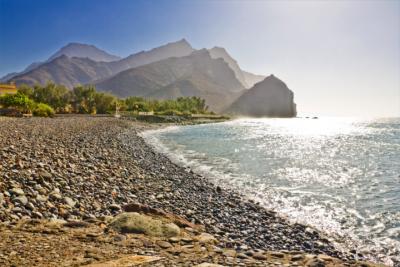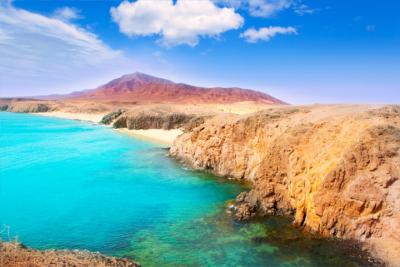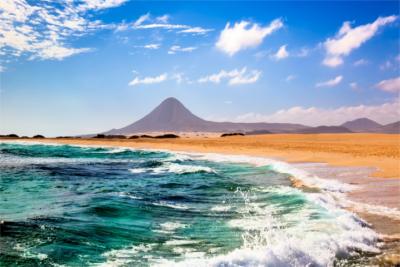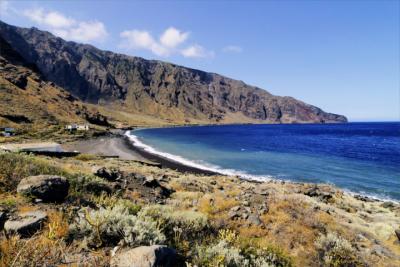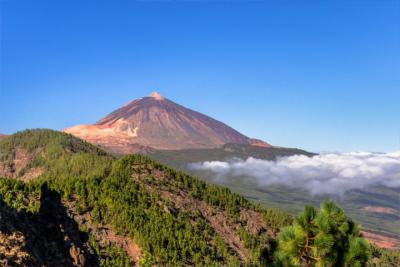Travel Offers
Travelmyne Featureprint
Distance
Fuerteventura - The Quiet Canary Island
Fuerteventura is considered the quiet island of the Canaries, which invites travellers to relax and rest. While its small bays and deserted beaches constitute great retreats, the harsh and appealing volcanic and desert landscape displays incomparable natural beauty.

Geography - A harsh, rugged landscape
Fuerteventura is located in the east of the Canary Islands, about 120 kilometres away from Africa. This strip of land in the Atlantic is about 100 kilometres long and 31 kilometres wide at its widest point. A long time ago, volcanoes shaped the island and created a harsh, rugged landscape with mountains of up to 800 metres of height. Fuerteventura is characterised by warm, mild climate throughout the year with average temperatures between 19 and 27 °C.

Nature - Discovering vast sand dunes and green oases
Vast, mighty sand dunes dominate the island's north-east. They mostly consist of small pieces of mussels and snail shells from the sea. The island's mountains with their reddish brown soils are equally barren. The areas covered in bright limestone, which used to be the seabed, and black volcanic soil create a natural play of colours. Palm oases constitute occasional green spots. Grasses, shrubs and date palms flourish in this harsh environment. The island's heartland is covered in fields, on which the medicinal plant aloe vera is grown. Many of the animals which live in Fuerteventura now originally come from Africa, for example the lively Barbary ground squirrel. Birds of prey, cockatiels as well as donkeys and camels, which are used as working animals, are also typical of the island.

Natural sights - From the Corralejo Natural Park to Jandía Peninsula
Travellers can experience the bizarrely beautiful landscape of the desert in the Corralejo Natural Park. The shifting dunes El Jable take up about 20 km². Their yellowish, reddish or white sand creates a strange but appealing landscape, which is populated by birds and reptiles for the most part. In addition, Corralejo has wonderful beaches. The island Los Lobos is part of the natural park and equally suited for bathing or surfing. In the north of Fuerteventura you find the lava cave Cueva del Llano. On a hike through this lava tunnel of about 700 metres of length you can hardly imagine the forces which created this natural wonder. Many fossilised plants and animals have been found in this cave. A popular holiday destination at the southern end of Fuerteventura is Jandía Peninsula with its magical beaches such as the Playa de Sotavento. The mountain Pico de Jandía stands out with regard to landscape. For entertainment you should visit the Oasis Park in La Lajita. This beautifully designed zoo hosts various shows with sea lions, parrots, birds of prey and reptiles.

Culture - Traditional music, wrestling matches and art handicraft characterise the island
For a long time the Guanches lived on Fuerteventura. They are native inhabitants of unknown origin. In the 15th century, the Spanish came to Fuerteventura and made the island part of their colonial empire. The population of Fuerteventura loves traditional music and wears elaborate costumes while dancing to it. A respectable sport is Spanish wrestling at which two opponents fight against each other. Art handicraft has a long tradition on the island. Fuerteventura is especially known for pottery, basketry and the production of lace, which is used for decorating traditional costumes, for example.

Cultural sights - The open air museum Tefia, windmills and salt gardens
Many visitors reach Fuerteventura via the capital Puerto del Rosario. If you take time to experience the town and walk its streets, you get a feel for the real life on the island. The town's harbour and its beaches are worth seeing. A visit to the restored farming village Ecomuseo La Alcogida in Tefia provides interesting insights into the native island culture. Performers in costumes, residential houses, a bakery, a stonemason and a pottery give holidaymakers an understanding of the traditional life on the island. This is also apparent from the El Morino windmill in Antigua, which is 200 years old and the most famous among Fuerteventura's many windmills. The small town La Oliva is full of historical charm, created by its church tower, which is made from black lava rock. The Salinas del Carmen with their square salt gardens show in what a technologically sophisticated way salt has been won from the sea water for centuries. You find testimonies of events which occurred even further in the past at the holy mountain Montaña de Tindaya. The Guanches once built their sacrificial altars there. One of the most popular destinations on Fuerteventura is the villa of the German engineer Gustav Winter. It is said that the Nazis had a secret submarine base there. The building's true appeal, however, lies in its stylish, ancient-looking construction and the wonderful view of the sea.

Experience - Enjoying celebrations, visiting aloe vera plantations and exploring the ocean floor
Fuerteventura is not just quiet. There are many discos, clubs and bars in the tourist centres which offer evening entertainment. It is this time at which the inhabitant show how much delight they take in celebrating, from traditional local fiestas to the international blues festival (March). The Windsurfing World Cup in summer and the International Kite Festival in November also attract numerous travellers. A special experience is a trip to an aloe vera factory. This plant is grown on the island and is a very popular souvenir (next to embroidery, art handicraft or table cloths). You learn more about the people's culture on the island's many markets such as the African market in Costa Calma. A trip to the ocean bed in a glass-bottom boat, as it is offered in Corralejo, is another wonderful experience. The most important ingredient of Fuerteventura's local cuisine comes from the sea: fish, prepared in a number of different ways. Other popular delicacies are jacket potatoes, which wrinkle because they are cooked in strongly salted water and which are eaten unpeeled, as well as spicy mojo sauces.

Activities - Ideally suited for surfing
Fuerteventura is windy at almost any time. This wind makes the island the ideal destination for holidaymakers who want to go surfong, sailing and kitesurfing. In addition, the beautiful beaches and bays are ideally suited for relaxing, sunbathing, swimming and snorkelling. You will discover many treasures, especially on diving tours - be it the colourful underwater world, which is rich in fish, the bizarre seascape or mysterious, decomposing wrecks. Travellers who want to explore the island's heartland can do this on foot, on the back of a horse or camel, by motorcycle or by quad bike.

Information
Fuerteventura's only international airport is located in Puerto del Rosario (FUE). From Europe you can also reach the island by ship. Fuerteventura has a well-developed bus network but you may need to rent a car to reach more remote places and beaches. The official language on the island is Spanish.
Fuerteventura is the perfect destination for holidaymakers who want to relax at the seaside in wonderful weather. It is especially suited for recreation in a quiet environment – be it at the beach, by doing sports or in the harsh landscape with its deserts, mountains and oases.

